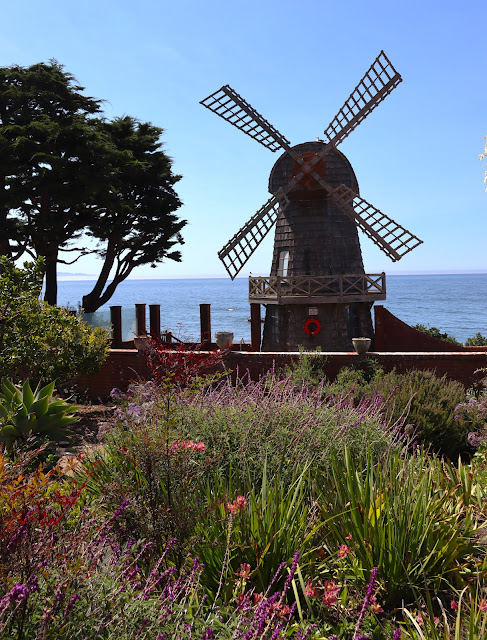Happy Holidays from the BirdCam on Cheltenham!
Tuesday, December 24, 2024
Saturday, December 7, 2024
Tiger Jaws!
Friday, December 6, 2024
Sundews and the Pollinator-Prey Conflict!
A "pollinator-prey conflict" arises in sundews, because they need insects both as pollinators for reproduction and as prey to acquire nutrients from nutrient-poor soil, creating a potential dilemma where they might trap and consume the very insects that help them pollinate their flowers. To mitigate this, many sundew species have evolved adaptations like spatially separating their flowers from their sticky traps, allowing them to attract pollinators without significantly risking their capture.
 |
| The beginning of a flower stalk on Drosera capensis aka Cape Sundew |
 |
| Flower stalk on Drosera capensis aka Cape Sundew |
 |
| Flower stalk on Drosera capensis aka Cape Sundew |
 |
| Flower stalk on Drosera capensis aka Cape Sundew |
 |
| Flower on Drosera capensis aka Cape Sundew |
 |
| Blooming Drosera capensis aka Cape Sundew |
 |
| Blooming Drosera capensis aka Cape Sundew |
Tuesday, December 3, 2024
How A Sundew Eats!
 |
| Drosera capensis ‘Cape sundew' |
This Drosera capensis aka Cape Sundew, is a carnivorous plant that has a fascinating process of capturing and digesting insects. The flat leaves on this sundew are covered in small stalked glands or tentacles. The tentacles are hair-like filaments, and at the end of is a small gland that produces a tiny drop of dew: a clear, gluey mucilage that is extremely sticky.
 |
| The Tentacles on Drosera capensis ‘Cape sundew' |
 |
| The Tentacles on Drosera capensis aka Cape Sundew |
A small flying insect may catch sight of the glistening droplets and mistake them for a flower's sweet nectar. It alights on the leaf and is immediately caught in the glue, and struggles to free itself. The more it thrashes, the more mired it becomes in the tentacles. The tentacles quickly begin to move, carrying the victim toward the center of the leaf, where more glands await.
 |
| A small insect caught in the tentacles of Cape Sundew |
 |
| A small insect caught in the tentacles of Cape Sundew |
 |
| The leaf is bending around a spider. Notice how the end of the tentacles have moved to trap and digest the spider. |
 |
| A leaf has folded to trap and digest a large insect. Notice the leaf on the left with many small bugs that have been trapped. The leaf doesn't fold on small insects. |
 |
| Drosera capensis ‘Cape sundew' |
Sunday, November 3, 2024
Blooming Surprises!
I was walking around the garden and was surprised to see some of these blooms.
 |
| Plumeria |
 |
| Epiphyllum |
 |
| Feather Cactus, AKA Mammillaria plumosa |
Thursday, October 31, 2024
Sunday, October 20, 2024
Sarracenia Hybrid Update!
I bought this Sarracenia hybrid of (x ‘Leah Wilkerson’) x (‘Wilkerson’s Red Rocket’) three months ago and at that time it had a couple of pitchers that were about 2 inches tall. Since then it has been growing new pitchers and they are getting wider and taller, but still under three inches. It will be going dormant in a couple of months and then next year I expect it to get much taller.
The pitcher on the right has been eating well! With the back lighting, you can see the level of dead and digested bugs in the pitcher. These are mostly ants! If you look at the pitcher on the left you can see a hole in the pitcher. A bug fell into the pitcher but could not climb out, but was able to eat a hole and escape!
I find these plants fascinating!
Tuesday, October 15, 2024
Walking Stick
Sunday, October 13, 2024
Bee in the Bloom!
Friday, October 11, 2024
Plant Sale in Santa Barbara!
If your in the Santa Barbara area, mark your calendar Saturday October 26th for a Plant Sale at Diane Dunhill's!
Wednesday, October 2, 2024
September Cactus Blooms!
This is one of my favorite cactus and I have had it for a long time, at least 15 years and possibly many more. It bloomed again a few days ago. I think this is the third time it has bloomed this year and it is every bit electrifying in person.
 |
| Rebutia Cactus |
The Flying Saucer Cactus bloomed earlier in September, It normally blooms in May and early June.
 |
| Flying Saucer Cactus |
 |
| This gives you an idea of the size of this flying cactus bloom. |
The next day it was 105° and the bloom didn't like the heat! I didn't like the heat either!
 |
Wednesday, September 25, 2024
A Tale of Two Caterpillars
So I saw the tell tale signs of fritillary caterpillars on my passion flower vine. There were lots of little holes in the leaves, so they were just getting started. Once they get going, they can defoliate the plant quickly! I began looking for the culprits. I found a bunch of eggs that I removed, but only one small caterpillar. I also found a white/beige caterpillar that I didn’t recognize and it was very wiggly. Instead of the usual squish method, I thought I’d feed them to my Venus flytrap! I dropped the Gulf Fritillary caterpillar into a trap and it closed instantly. The fly trap did its job and started digesting the caterpillar. A few days later, the trap opened and you can see the remains.
 |
| The remains of a Gulf Fritillary cater pillar in a Venus Flytrap |
 |
| A closed Venus Flytrap with a hole where an unidentified caterpillar escaped! |
Friday, September 20, 2024
Tuberous Begonias - Paul Carlisle & Chapman Estate
Our begonia branch (Rudolf Ziesenhenne, Santa Barbara, CA) recently visited Paul Carlisle's shade-house and the Chapman Estate shade-house to see tuberous begonias. It was a tuberous double feature!
If your familiar with my blog, you have seen the tuberous begonias grown by Paul Carlisle. They are incredible! I would confidently say that Paul Carlisle is the best tuberous begonia grower in the United States! It's always a treat to visit his shade-house when the tuberous are in full bloom! Here are pictures taken in Paul's shade-house.
 |
| Tuberous Begonias, Grown by Paul Carlisle |
 |
| Tuberous Begonias, Grown by Paul Carlisle |
 |
| Tuberous Begonia, Grown by Paul Carlisle |
 |
| Tuberous Begonia, Grown by Paul Carlisle |
 |
| Tuberous Begonia, Grown by Paul Carlisle |
 |
| Tuberous Begonia, Grown by Paul Carlisle |
 |
| Tuberous Begonias, Grown by Paul Carlisle |
 |
| Tuberous Begonia, Grown by Paul Carlisle |
 |
| Tuberous Begonia, Grown by Paul Carlisle |
 |
| Tuberous Begonia, Grown by Paul Carlisle |
 |
| Tuberous Begonia, Grown by Paul Carlisle |
 |
| Tuberous Begonia, Grown by Paul Carlisle |
 |
| Tuberous Begonias, Grown by Paul Carlisle |
 |
| Tuberous Begonia, Grown by Paul Carlisle |
 |
| Tuberous Begonias, Grown by Paul Carlisle |
 |
| Tuberous Begonia, Grown by Paul Carlisle |
The Chapman Estate
Paul takes care of the tuberous begonias at the Chapman Estate in Pismo Beach CA. The Chapman Estate was bequeathed to the City of Pismo Beach in 2013. Clifford Chapman directed that the estate be open to the public, designated non-profit organizations, and private events. You can learn more at their website Chapman Estate Foundation.
 |
| The Chapman Estate |
 |
| The Chapman Estate |
 |
| The Chapman Estate |
 |
| The Chapman Estate |
 |
| The Chapman Estate |
 |
| The Chapman Estate |
 |
| The Chapman Estate |
 |
| The Chapman Estate |
 |
| The Chapman Estate |
 |
| The Chapman Estate |
 |
| The Chapman Estate |
 |
| The Chapman Estate |
 |
 |
| The Chapman Estate |
 |
| The Chapman Estate |
 |
| The Chapman Estate |
 |
| The Chapman Estate |
 |
| Brown Pelicans |
 |
| Brown Pelicans |


















